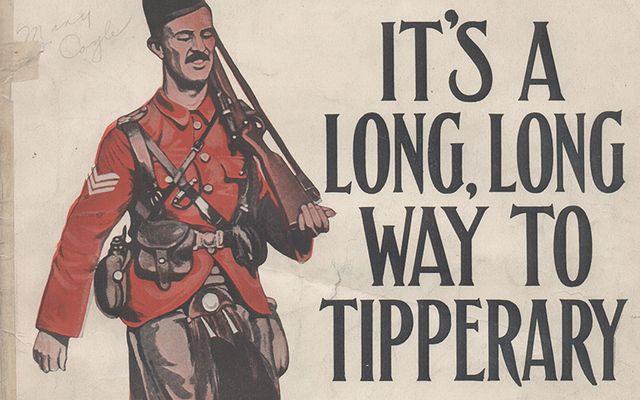Entertainment
Uncovering the Legacy of “It’s a Long Way to Tipperary”

The song “It’s a Long Way to Tipperary” has come to symbolize both British and Irish culture, despite its widespread perception as a British anthem. Written by Englishman Jack Judge in January 1912, it reflects a soldier’s yearning for his sweetheart back home in Tipperary. Though commonly attributed solely to British origins, the song’s history reveals a deeper connection to both cultures.
Judge, who transitioned from a fishmonger to a songwriter, claimed to have composed the piece overnight. An article in the Financial Times, however, challenges this narrative, presenting evidence that Judge had previously collaborated with Harry Williams on a song titled “It’s a Long Way to Connemara.” This earlier piece featured a young Irish lad longing for his Connemara sweetheart. Judge altered the lyrics to replace Connemara with Tipperary, a nod to his grandmother’s roots, and sold the publishing rights to music publisher Bert Feldman.
Feldman transformed the song into an upbeat marching tune, which quickly gained popularity. The song sold an impressive three million copies in the UK and six million worldwide, becoming a staple for soldiers during World War I. Its popularity soared further when renowned tenor Count John McCormack recorded it. In 1915 alone, Judge and Williams earned over $750,000 in royalties, a staggering sum for the time. Even today, the song generates approximately $40,000 annually for Judge’s family, as the copyright remains active.
The song’s rise to fame can be traced to its first public mention by George Curnock, a journalist for the Daily Mail, who reported that a battalion of Connacht Rangers sang it while disembarking in France. The Daily Mail subsequently published the lyrics, solidifying its status as an iconic wartime tune. Soldiers often sang it alongside another popular song, “Pack Up Your Troubles in Your Old Kitbag,” as they marched off to war.
Despite his early success, Judge faced financial difficulties later in life and sold his share of the song’s rights to Williams, who subsequently donated substantial amounts to support wounded soldiers. A cheeky, bawdy version of the song emerged, titled “That’s the Wrong Way to Tickle Mary,” although its explicit content has relegated it to obscurity.
The cultural impact of “It’s a Long Way to Tipperary” extends beyond music. It even inspired a beloved character from the comic strip “Peanuts,” where Snoopy humorously imagines himself as a World War I flying ace. In one memorable panel, he remarks after a long journey, “They’re right, it is a long way to Tipperary,” upon arriving at a sign indicating just one block left to the town.
The song also made a significant mark in the arts, featuring prominently in the acclaimed play and subsequent film “Oh What a Lovely War,” which tackled the grim realities of war with a satirical flair.
Today, Tipperary is not only known for its musical legacy but also for the Tipperary Peace Prize, awarded annually to individuals who have made significant contributions to peace efforts globally. The evolution of this song from a soldier’s lament to a symbol of both cultural heritage and peace showcases its enduring relevance, resonating far beyond its original context.
Thus, “It’s a Long Way to Tipperary” stands as a testament to the power of music in shaping cultural identity and reflecting the shared experiences of people across borders.
-

 Top Stories3 months ago
Top Stories3 months agoTributes Surge for 9-Year-Old Leon Briody After Cancer Battle
-

 Entertainment4 months ago
Entertainment4 months agoAimee Osbourne Joins Family for Emotional Tribute to Ozzy
-

 Politics4 months ago
Politics4 months agoDanny Healy-Rae Considers Complaint After Altercation with Garda
-

 Top Stories4 months ago
Top Stories4 months agoIreland Enjoys Summer Heat as Hurricane Erin Approaches Atlantic
-

 World5 months ago
World5 months agoHawaii Commemorates 80 Years Since Hiroshima Bombing with Ceremony
-

 Top Stories3 months ago
Top Stories3 months agoNewcastle West Woman Patricia Foley Found Safe After Urgent Search
-

 Top Stories5 months ago
Top Stories5 months agoFianna Fáil TDs Urgently Consider Maire Geoghegan-Quinn for Presidency
-

 World5 months ago
World5 months agoCouple Convicted of Murdering Two-Year-Old Grandson in Wales
-

 World5 months ago
World5 months agoGaza Aid Distribution Tragedy: 20 Killed Amid Ongoing Violence
-

 World5 months ago
World5 months agoAristocrat Constance Marten and Partner Convicted of Infant Murder
-

 Top Stories4 months ago
Top Stories4 months agoClimbing Errigal: A Must-Do Summer Adventure in Donegal
-

 Top Stories4 months ago
Top Stories4 months agoHike Donegal’s Errigal Mountain NOW for Unforgettable Summer Views









